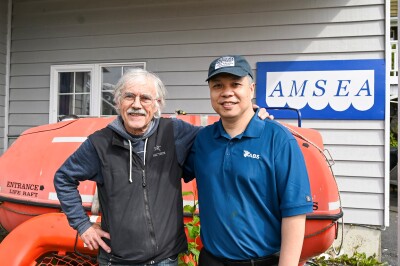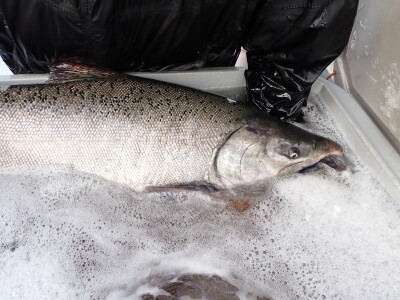Gulf/South Atlantic Grouper
Water temps put a chill on fishing, but dock prices and quotas stay hot
Fishermen have had to work a bit harder to fish out their red grouper quotas in 2013 after last year's record $16.8 million harvest. But average ex-vessel prices continue to climb in Florida, where roughly 95 percent of landings make port each year, most at a handful of Tampa Bay area seafood houses.
Through the first three seasons following the 2010 implementation of the gulf's grouper-tilefish IFQ program, the fishery has experienced growth in ex-vessel price, total dollar value and, as the total allowable catch and commercial quota has increased each year, in pounds harvested. Average full-year ex-vessel prices in Florida rose from $2.39 a pound in 2009 to $2.73 in 2012.
One advantage of the IFQ system is that fishermen can fish harder at a time and place of their choosing if conditions are less than ideal early in the season, which was the case this year.
"It's been slow thus far this year," said Cedar Key fisherman Russ Sill in April.
Sill, who fishes with partner Dave Mays, said he thought colder than normal water temperatures on the fishing grounds had hurt the fishing. "This year we averaged 1,300 [pounds] or so," he said, considerably off their normal per-trip haul of a ton or more.
The water temperature anomaly persisted into summer, says Lee Deaderick, co-owner of Northwest Seafood in Gainesville. "The grouper bite seems to be slow in our corner of the gulf," he says. "Bottom temp seems to be fairly cold. The bite has been off since April."
Nevertheless, fishermen seem confident in the fishery and are enjoying very good prices. Dean Pruitt, who fishes the Maritza out of Madeira Beach, says prices hit $3.80 the third week of August.
"It's been a little slow but still better than 2008, 2009," the two years prior to the BP oil spill, he says. "We've had a good year. We're doing fine."
Pruitt is so confident in fishing prospects under the IFQ program that he made a major investment in a new business, Save on Seafood Fishing, a Madeira Beach waterfront fish house.
"We've got a year-round fishery, and we're making more money than we ever have," he says.
Even in a year when most components of a successful season seem to line up, Gulf of Mexico fishermen worry about hurricanes. And that's especially so this year, with experts predicting an active storm season.
No major storms had plagued the gulf through the end of August. However, Tropical Storm Andrea may have churned up the water when visiting the region on June 10 and been partly responsible for extending the cold temperature anomaly from earlier in the year. Temperatures off Florida's Gulf Coast were uniformly cooler than normal after the storm moved through the southeastern Gulf of Mexico and across the Middle Grounds and Florida's Big Bend.
However, the cooler water began much earlier; NOAA sea surface temperature charts show exactly what Sill mentioned in April. NOAA's satellite data-derived charts showed water off the coast cooling in late March and temperatures dropping dramatically in early April. Florida's entire Gulf Coast on April 1 was 1.5 to 2 degrees cooler than normal with some spots reaching 3.5 to 4 degrees below normal.
As of late August, a large area of cooler than normal water persisted through the Florida Straits and well into the gulf south of the Middle Grounds. Such cool surface temperatures are good news in hurricane season because they literally have a chilling effect on tropical systems.
As of August, NOAA was still forecasting an above-normal tropical weather season, predicting six to nine hurricanes. — Hoyt Childers
Alaska & Pacific Pollock
Russian fleet cleared for MSC approval; Alaska keeps an eye on European edge
Russia's trawl industry scored a victory in its bid to earn Marine Stewardship Council endorsement for pollock. A new blue-labeled fishery could increase fillet supplies in European markets.
Meanwhile, domestic fillet sales remain steady as consumers realize pollock's potential to fill the whitefish niche. The softening yen continues to dampen prices for roe shipped to Japan. And surimi production is tracking closely with last year's output.
Russia's trawl industry began vying for MSC's blue ecolabel in 2010. The process can take years as the fishery undergoes assessments and scoring on 31 standards. Independent reviewers weigh the validity of input from the client industry, management agencies and objecting interests.
In August, an independent adjudicator remanded the pollock petition to the certification board to address questions about how eight assessment factors were scored. The scoring of one of those eight performance indicators deviates from proper procedure.
Revising that one score justified changes to the remaining seven, which kicked the fishery's total score to the minimum needed for MSC approval.
The Seattle-based At-Sea Processors Association filed a formal protest, arguing that such changes would allow information to be introduced that wasn't included when the certification process began.
"We cried foul at that," says Jim Gilmore, the association's public affairs director. "You can't just say that you found some new information in the 11th hour and raise the score."
The certifying board and independent adjudicator Michael Lodge returned a decision on Sept. 16 that the fishery passes the MSC standard and is cleared for approval. Meanwhile, with the Sea of Okhotsk fishery's certification, European buyers could begin sourcing fillets from Russia instead of the United States.
"There are a lot of moving parts to it, which creates uncertainty in the marketplace," Gilmore says.
When the U.S. contingent of the Bering Sea pollock fishery won its first certification in 2005, it increased European demand for their product.
"We've always had a little bit of an edge with the MSC label," says Marc Wells, president of Genuine Alaska Pollock Producers, in Seattle.
But another selling point for U.S. product is that the fillets are shipped over as single-frozen. Whether Russia, with MSC approval, would reconfigure processing plants to produce single-frozen product and compete with the United States in European markets or continue its practice of shipping its headed and gutted pollock to China for reprocessing and distribution of twice frozen fillets to other markets, remains to be seen, Wells says.
"I'm not sure anything will change," he says.
On the domestic front, fillets continue to enjoy steady demand from school lunch programs and other public venues, says Pat Shanahan, GAPP program director. For the past five years, GAPP has worked to familiarize consumers with pollock fillets. Of late, consumers have begun asking for recipes and more ways to prepare the fish.
"It's a huge change from five years ago when we started the project and people didn't even know what pollock was," Shanahan says.
Pollock roe sales have begun sliding in correlation to the weakening yen. NMFS foreign trade data shows exports to Japan slipped from some 8 million kilos worth $56.2 million in 2011 to 7.6 million kilos worth $46.8 million in 2012. Through June of this year, 6.2 million kilos valued at $39.6 million had been shipped to Japan.
The yen's annual average value, meanwhile, held steady at around 80 to the dollar in 2011 and 2012, but this year had weakened to 96 through August.
Surimi production is tracking very closely with last year, Wells says. In 2011, the Alaska industry exported 133 million kilos to countries worldwide. Volumes in 2012 totaled around 150 million kilos, and through August of this year, exports stood at 69.4 million kilos. — Charlie Ess






